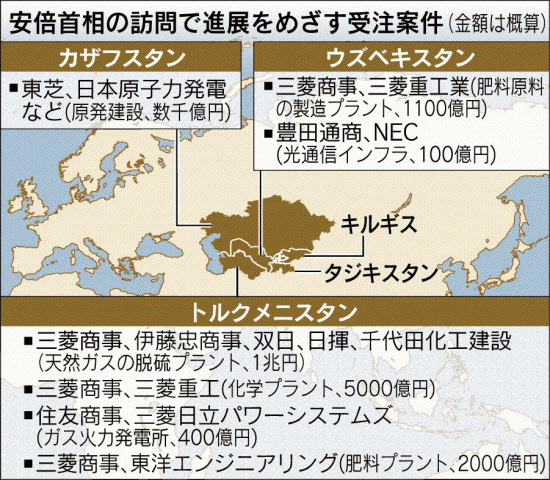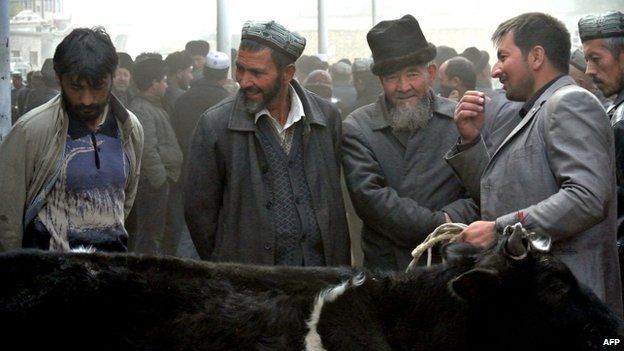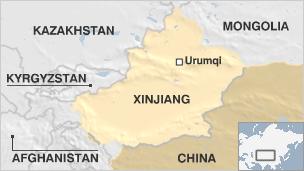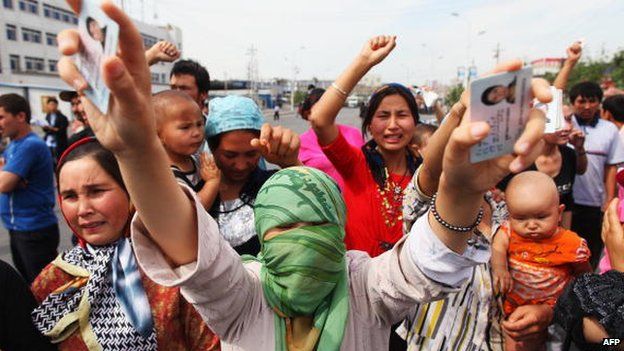ウイグルの噂は原発があるのでよく目にします。
でも、それが何処にあり誰が住んでいて
何故原発で被ばくしてる人が大勢いると言われてるのに
その実態がまるで解らないのだろう?
いつも疑問に思ってました。
良い記事を見つけたので
考えてみたいと思います。
ウイグルって日本語読みなので英語、中国語では
新疆=しんきょう=Xinjiang Uighur=(シィンヂュャング ウィガァ)
っていうのを頭に入れて
地図を見ながら考えてました。
昨年、近隣のシルクロードの匡 へ安倍総理が歴訪して
お金ばらまいています。
この周辺はとても豊かな国だったようですが
ウイグル自治区(東トルキスタン)は何処にあり、誰が住んでるのか?
ーーwiki Quote ーー
中国北西部のジュンガル (準 噶爾) 盆地を含む地方の呼称。清の乾隆帝時代に準,回 (中央アジアのモンゴルとウイグル) 両部を平定したのち,この地方を「新たに加わった領域」の意味で新疆と名づけた。
The Xinjiang autonomous region in China's far west has had a long history of discord between the authorities and the indigenous ethnic Uighur population. The BBC sets out why.
中国の遠西の新疆自治区は、当局と先住民のウイグル人民族の間に長い歴史がありました。 BBCは理由を述べる。
ーーーend--^

ーーwikiによるとーー漢民族視点の呼称に「新疆」があり、中華民国は1912年からこの地を新疆省としている。1949年に中華人民共和国の支配下に入ると、新疆ウイグル自治区と命名された。中国領トルキスタン[要出典]、ウイグルスタン、東トルケスタンとも呼ばれる。
南にチベット自治区および青海省、東に甘粛省、北東にモンゴル国と接しており、北西から南西にかけては、カザフスタン、キルギス、タジキスタン等西トルキスタン地域と呼称される旧ソビエト連邦領中央アジア諸国、インド・パキスタン間で係争中のカシミール(アクサイチン)地方などと接している。
――中略ーー
東トルキスタンの住民の約45%はウイグル族が占めているが、他にも漢族、カザフ族、回族、モンゴル族、満族など多くの民族が居住している。特に、中華人民共和国成立以後は漢族の流入が著しい。北西部には漢族と回族が多く、南西部にウイグル族が多い。
ーーーend--^
☞東トルキスタン(ウイグル)の記事3つ・歴代首相と胡錦濤の朝食会での安倍発言で緊張走る・【櫻井よしこ 福田首相に申す】「文化の虐殺」粛々と進行中・ウイグルでも3月にデモ「イチパック」のアクバロフ代表
☞安倍晋三首相、トルクメニスタン タジキスタン ウズベキスタン 歴訪 約3兆円規模!

2014年9月26日
♦Who lives in Xinjiang? 新疆に住む人は誰ですか?

The largest of China's administrative regions, Xinjiang borders eight countries - Mongolia, Russia, Kazakhstan, Kyrgyzstan, Tajikistan, Afghanistan, Pakistan and India - and until recently its population was mostly Uighur.
モンゴル、ロシア、カザフスタン、キルギスタン、タジキスタン、アフガニスタン、パキスタン、インドの8カ国に接し、最近まで人口のほとんどウイグル人だった。

Most Uighurs are Muslim and Islam is an important part of their life and identity. Their language is related to Turkish, and they regard themselves as culturally and ethnically close to Central Asian nations.
ほとんどのウイグル人はイスラム教徒であり、イスラムは彼らの人生とアイデンティティの重要な部分です。 彼らの言語はトルコ語に関連しており、彼らは文化的にも民族的にも中央アジア諸国に近いと考えられています。
The region's economy has largely revolved around agriculture and trade, with towns such as Kashgar thriving as hubs along the famous Silk Road.
この地域の経済は主に農業と貿易を中心に展開しており、有名なシルクロードの拠点として繁栄しているカシュガルなどの町があります。
But development has brought new residents. In the 2000 census, Han Chinese made up 40% of the population, as well as large numbers of troops stationed in the region and unknown numbers of unregistered migrants.
しかし、開発は新しい住民をもたらしました。 2000年の国勢調査では、漢民族は人口の40%を占めただけでなく、この地域に駐留する多数の軍隊と未登録の移住者の数は不明です。
♦Has Xinjiang always been part of China?
新疆は常に中国の一部でしたか? -
The region has had intermittent autonomy and occasional independence, but what is now known as Xinjiang came under Chinese rule in the 18th Century.
この地域は断続的な自主性と時折の自立を保っていますが、現在新疆として知られているのは18世紀から中国統治下にあるからです。
An East Turkestan state was briefly declared in 1949, but independence was short-lived - later that year Xinjiang officially became part of Communist China.
東トルキスタンの国家は1949年に簡潔に宣言されましたが、独立は短命でした - その後、新疆は公式に中国共産党の一部となっています。
In the 1990s, open support for separatist groups increased after the collapse of the Soviet Union and the emergence of independent Muslim states in Central Asia.
1990年代には、ソビエト連邦の崩壊と中央アジアの独立したイスラム諸国の出現の後に分離勢力グループの開放的な支持が増加しました。
However, Beijing suppressed demonstrations and activists went underground.
しかし、北京はデモを抑制し、活動家は地下に逃げました。
プロフィール:新疆自治区
Profile: Xinjiang autonomous region
What is at the heart of the unrest?
不安の中心には何がありますか?
While the situation is complex, many say that ethnic tensions caused by economic and cultural factors are the root cause of the recent violence..
状況は複雑ですが、多くの人は、経済的および文化的要因によって引き起こされた民族的緊張が最近の暴力の根本原因であると言います。
Major development projects have brought prosperity to Xinjiang's big cities, attracting young and technically qualified Han Chinese from eastern provinces.
主要な開発プロジェクトは、新疆の大都市に繁栄をもたらし、東部から若くて技術的に妥当な漢族を集めています。
The Han Chinese are said to be given the best jobs and the majority do well economically, something that has fuelled resentment among Uighur
漢族は最高の雇用を得ていると言われており、その大部分は経済的に裕福で、ウイグル人の怒りをかっています。

Activists say Uighur commercial and cultural activities have been gradually curtailed by the Chinese state. There are complaints of severe restrictions on Islam, with fewer mosques and strict control over religious schools.
活動家は、ウイグルの商業活動と文化活動は、中国の国家によって徐々に縮小されていると言います。 イスラム教には厳しい制限の苦情があり、モスクの数が少なく、宗教学校を厳しく管理しているという苦情があります。
Rights group Amnesty International, in a report published in 2013, said authorities criminalised "what they labelled 'illegal religious' and 'separatist' activities" and clamped down on "peaceful expressions of cultural identity".
アムネスティ・インターナショナルは、2013年に発行された報告書で、「違法宗教」と「分離主義」活動を「何を標識したもの」を犯罪と認定し、「文化的アイデンティティの平和的表現」を締結したと述べました。
In July 2014, some Xinjiang government departments banned Muslim civil servants from fasting during the holy month of Ramadan. It was not the first time China had restricted fasting in Xinjiang, but it followed a slew of attacks on the public attributed to Uighur extremists, prompting concerns the ban would increase tensions.
2014年7月、新疆政府の一部の省庁は、ラマダンの聖月の間に、イスラム教徒の公務員の断食を禁止しています。 中国が新疆ウイグル自治区で断食を初めて制限したのは初めてではなかったのですが、ウイグル人の過激派による国民に対する攻撃が多発し、禁止が緊張を高めてしまうのではないかと懸念しました。
Making sense of the unrest from China's Xinjiang
中国の新疆からの不安を感じる
Death on the Silk Route: Violence in Xinjiang
シルクルートの死:新疆の暴力
How has the violence developed?
暴力はどのように発展しましたか?
China has been accused of intensifying its crackdown on the Uighurs after street protests in the 1990s and again in the run-up to the Beijing Olympics in 2008.
中国は、1990年代の街頭抗議や2008年の北京五輪への参戦で、ウイグル人の一層の勢力強化を訴えた。
But things really escalated in 2009, with large-scale ethnic rioting in the regional capital, Urumqi. Some 200 people were killed in the unrest, most of them Han Chinese, according to officials.
しかし、地方首都ウルムチで大規模な民族暴動が発生し、2009年に事態が本当に高まった。 関係者によると、約200人が不安で殺されたが、そのほとんどはハン・チャイナであった。

Security was increased and many Uighurs detained as suspects. But violence rumbled on as right groups increasingly pointed to tight control by Beijing.
In June 2012, six Uighurs reportedly tried to hijack a plane from Hotan to Urumqi before they were overpowered by passengers and crew.
セキュリティが強化され、多くのウイグル人が容疑者として拘留された。しかし、右派グループが北京の厳格な管理を指摘するにつれて、暴力行為が激しさを増した。
2012年6月、6人のウイグル人が乗客と乗組員によって圧倒される前に、ホータンからウルムチへ飛行機をハイジャックしようとしたと伝えられています。
There was bloodshed in April 2013 and in June that year, 27 people died in Shanshan county after police opened fire on what state media described as a mob armed with knives attacking local government buildings
Establishing facts about these incidents is difficult, because foreign journalists' access to the region is tightly controlled, but in recent months, there appears to have been a shift towards larger-scale incidents where citizens have become the target, particularly in Xinjiang.
2013年4月には流血が起き、その6月に警察が地方政府の建物を攻撃するナイフで武装した武装勢力と発言したことで警察が発砲した後、山山郡で27人が死亡しました。
外国人ジャーナリストの地域へのアクセスは厳重に管理されているため、これらの事件に関する事実を確立することは困難ですが、近年、特に新疆では市民が対象となった大規模事件に移行しているようです。
At least 31 people were killed and more than 90 suffered injuries in May 2014 when two cars crashed through an Urumqi market and explosives were tossed into the crowd. China called it a "violent terrorist incident".
2014年5月、ウルムチ市場で2台の車が墜落し、爆薬が群衆に投げ込まれたとき、少なくとも31人が死亡し、90人以上が怪我を負った。中国はそれを「暴力的テロ事件」と呼んだ。
It followed a bomb and knife attack at Urumqi's south railway station in April, which killed three and injured 79 others.
それは4月にウルムチの南駅で爆弾とナイフの攻撃を受け、3人が死亡し79人が負傷した。
In July, authorities said a knife-wielding gang attacked a police station and government offices in Yarkant, leaving 96 dead. The imam of China's largest mosque, Jume Tahir, was stabbed to death days later.
7月、当局はナイフをつかむ団体が警察署とヤルカントの政府庁舎を攻撃し、96人が死亡したと述べた。中国最大のモスク、ume Tahirのイマームが死日に刺された。
In September about 50 died in blasts in Luntai county outside police stations, a market and a shop. Details of both incidents are unclear and activists have contested some accounts of incidents in state media.
9月には、警察署の外にあるルンタイ郡の市場で約50人が爆発で死亡した。両方の事件の詳細は不明であり、活動家は州のメディアで事件の一部について論争している。
Some violence has also spilled out of Xinjiang. A March stabbing spree in Kunming in Yunnan province that killed 29 people was blamed on Xinjiang separatists, as was an October 2013 incident where a car ploughed into a crowd and burst into flames in Beijing's Tiananmen Square.
いくつかの暴力も新疆から流出しています。
3月に 雲南省の昆明で29人が死亡したことで、新疆の分離勢力が非難されました。
2013年10月、北京の天安門広場で車が群衆に吹き込まれ、炎に爆発した。
In response to the latest slew of attacks, the authorities have launched what they call a "year-long campaign against terrorism", stepping up security in Xinjiang and conducting more military drills in the region.
最新の攻撃に対応して、当局は新疆ウイグル自治区の安全保障を強化し、この地域でより多くの軍事訓練を実施する、「テロとともに1年間のキャンペーン」を開始した。
There have also been reports of mass sentencings and arrests of several "terror groups". Chinese state media have reported long lists of people convicted of extremist activity and in some cases, death sentences.
いくつかの「テロ集団」の大量告発と逮捕の報告もある。 中国の国営メディアは、過激派活動の有罪判決を受けた人々のリストや死刑判決を報告している。
High-profile Uighur academic, Ilham Tohti was detained and later charged in September 2014 on charges of separatism., sparking international criticism.
Shock and anger after Kunming brutality
China tries to block Xinjiang blast memorial
Who's to blame?
誰が責任を負うのですか?
China has often blamed ETIM - the East Turkestan Islamic Movement - or people inspired by ETIM for violent incidents both in Xinjiang and beyond the region's borders.
中国はしばしばETIM(東トルキスタンのイスラム運動)、あるいは新疆ウイグル自治区や辺境地域を越えて暴力的な事件が起きた場合にETIMに触発された人々を非難している。
ETIM is said to want to establish an independent East Turkestan in China. The US State Department in 2006 said ETIM is "the most militant of the ethnic Uighur separatist groups".
ETIMは、中国に独立した東トルキスタンを設立したいと言われています。 2006年の米国国務省は、ETIMは「ウイグル族民族分離主義組織の中で最も戦闘的である」と述べた。
The scope of ETIM's activities remains unclear with some questioning the group's capacity to organise serious acts of extremism.
ETIMの活動の範囲は、極度の重大な行為を組織するグループの能力に疑問を呈しても不明確なままである。
ETIM has not said it was behind any of the attacks. Chinese authorities said the Turkestan Islamic Party - which it says is synonymous with ETIM - released a video backing the Kunming attack, however.
ETIMは攻撃の背後にあるとは言いませんでした。 中国当局は、トルコのイスラム党(ETIMと同義)は、昆明の攻撃を裏付けるビデオを公開したと述べた。
With the recent apparent escalation in Xinjiang-related violence, the question of who and what is driving it is likely to attract greater scrutiny.
最近、新疆関連の暴力が明らかに拡大したことで、誰が何を運転しているのかという疑問が、より厳しい監視を引き付ける可能性が高い。
Q&A: East Turkestan Islamic Movement
Q&A:東トルキスタンのイスラム運動
最後まで読んでくれてありがとう(*^-^*) ポチッとよろしく
follow Hikaru on facebook ☞Hikaru FB Timeline
and twitter ☞ヒカル(反原発)
楽しく明るく暮らせるように繋がりませんか? ☞小さな蟻の会


